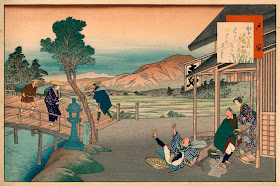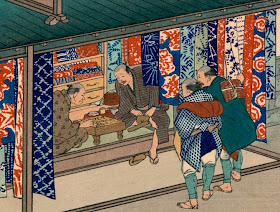 Legend has it that Japanese author Jippensha Ikku (1765-1831) spent so much money drinking that he could not afford to furnish his home. Instead, he simply hung pictures of furniture he would have bought. One New Year's, when he found himself without proper holiday attire, he offered a visitor a bath and took off with the man's nice clothes to pay some visits of his own. And on his deathbed, he had firecrackers secretly stowed in his funeral pyre, to go out with a bang, if you will.
Legend has it that Japanese author Jippensha Ikku (1765-1831) spent so much money drinking that he could not afford to furnish his home. Instead, he simply hung pictures of furniture he would have bought. One New Year's, when he found himself without proper holiday attire, he offered a visitor a bath and took off with the man's nice clothes to pay some visits of his own. And on his deathbed, he had firecrackers secretly stowed in his funeral pyre, to go out with a bang, if you will.Sadly, these tales are probably untrue, a result of Jippensha being conflated with his clownish characters. Yaji and Kita, the traveling duo in his novel Footing It along the Tōkaidō Road, are always trying to trick their way into free meals and free rides, and into the beds of attractive young witches. Usually their schemes backfire. For instance, in a meta-referential moment, Yaji boasts to a local that he is in fact the famous writer Jippensha Ikku, researching for an upcoming book called (you guessed it) Footing It along the Tōkaidō Road. The local is impressed and treats Yaji at his home, but when a letter arrives from the real Jippensha, Yaji is forced admit his deception and flee.
 At the time, the book functioned both as an entertaining story and as an informational travelogue, sketching out the varying customs and scenery along the eastern coast. Rauner's edition features 60 full-page illustrations by print maker Tamenobu Fujikawa. The landscapes, which often dwarf the characters, provide moments of pause to accompany the fast-paced narrative. The prints' detailed use of patterns is impressive, especially considering that each color had to be carved from a separate block of wood and perfectly aligned. Such work was done not by the artist alone but by a team who specialized in each stage of the printmaking process. As the book goes on, you can see the level of detail on the faces change, reflecting differing interpretations of the artist’s original drafts.
At the time, the book functioned both as an entertaining story and as an informational travelogue, sketching out the varying customs and scenery along the eastern coast. Rauner's edition features 60 full-page illustrations by print maker Tamenobu Fujikawa. The landscapes, which often dwarf the characters, provide moments of pause to accompany the fast-paced narrative. The prints' detailed use of patterns is impressive, especially considering that each color had to be carved from a separate block of wood and perfectly aligned. Such work was done not by the artist alone but by a team who specialized in each stage of the printmaking process. As the book goes on, you can see the level of detail on the faces change, reflecting differing interpretations of the artist’s original drafts.If you can’t read Japanese, you're not alone. Illiterate Japanese in the nineteenth century would commonly buy books just for the printed illustrations, too. But unlike them, you can view this one online from our Digital Library Program, or ask for Rare Book PL797 D62 1800z.

No comments:
Post a Comment